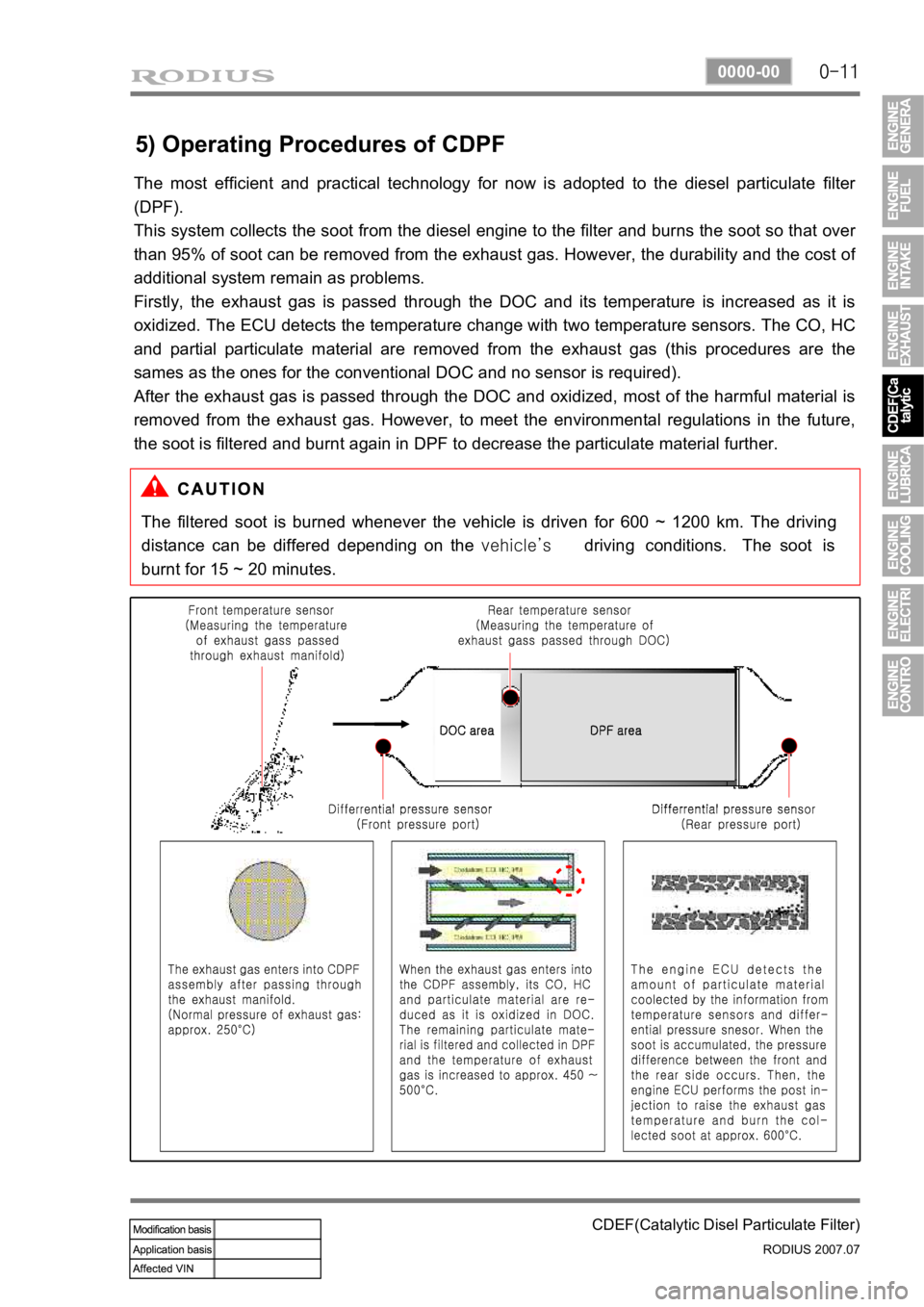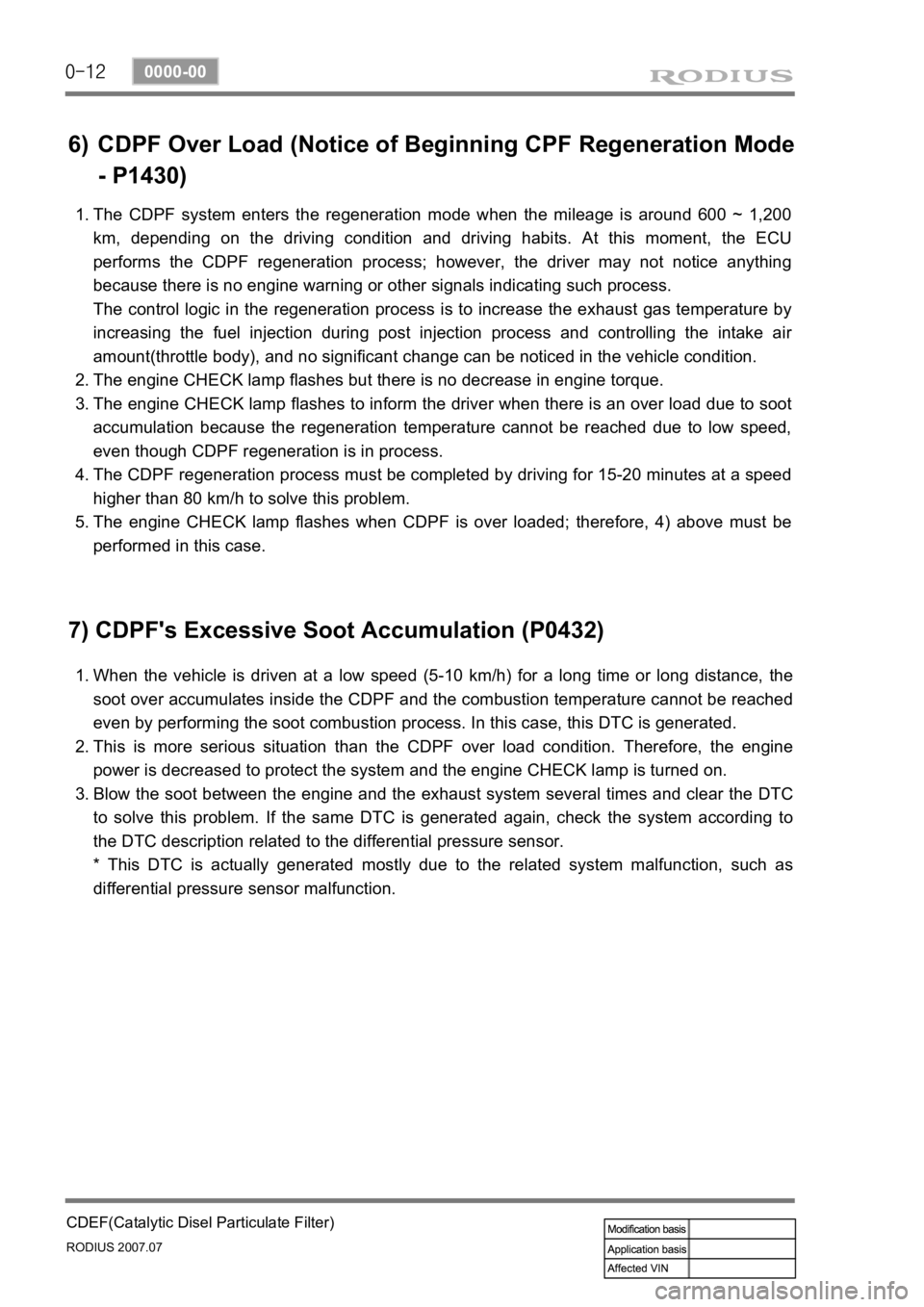Page 154 of 444

0-9
CDEF(Catalytic Disel Particulate Filter)
RODIUS 2007.07
0000-00
2) Sytem Composition for Soot Combustion
When the engine is running in low load range, the temperature of exhaust gas is decreased as
the amount of fuel supplied is decreased. To burnt the soot filtered in the CDPF, the control
system should be installed to check the operating range and increase the temperature o
f
exhaust gas by controlling the amount of fuel supplied and and intake air.
Two temperature sensors and one differential pressure sensor monitor the CDPF's operating
range. According to theses sensors' information, the throttle flap decreases the intake ai
r
entered to the throttle body. Also, the fuel injection pattern is added to increase the temperature
of exhaust gas for soot combustion.
There are two fuel injection patterns (pilot injection and main injection). As the CDPF is
installed, the post injection pattern is added.
3) Post Injection and Air Mass Control
When the differential pressure sensor detects the pressure difference between the front and the
rear side of CDPF, the sensor sends signal indicating the soot is acumulated and the post
injection is performed to raise the temperature of exhaust gas. The amount of fuel injected is
determined according to the temperature of exhaust gas detected by the rear temperature
<009a008c0095009a00960099005500470070008d0047009b008f008c0047009b008c00940097008c00990088009b009c0099008c00470090009a00470089008c00930096009e0047005d0057005700b6006a00530047009b008f008c004700880094009600
9c0095009b00470096008d0047008d009c008c009300470090>njected is increased to
<009900880090009a008c0047009b008f008c0047009b008c00940097008c00990088009b009c0099008c005500470070008d0047009b008f008c0047009b008c00940097008c00990088009b009c0099008c00470090009a00470096009d008c0099004700
5d0057005700b6006a00530047009b008f008c004700880094>ount of fuel injected is
decreased or not controlled.
When the engine is running in low load range, the amount of post injection and the amount of
intake air are controlled.
It is to raise the temperature by increasing the amount of fuel while decreasing the amount of
intake air.
Page 156 of 444

0-11
CDEF(Catalytic Disel Particulate Filter)
RODIUS 2007.07
0000-00
5) Operating Procedures of CDPF
The most efficient and practical technology for now is adopted to the diesel particulate filter
(DPF).
This system collects the soot from the diesel engine to the filter and burns the soot so that ove
r
than 95% of soot can be removed from the exhaust gas. However, the durability and the cost o
f
additional system remain as problems.
Firstly, the exhaust gas is passed through the DOC and its temperature is increased as it is
oxidized. The ECU detects the temperature change with two temperature sensors. The CO, HC
and partial particulate material are removed from the exhaust gas (this procedures are the
sames as the ones for the conventional DOC and no sensor is required).
After the exhaust gas is passed through the DOC and oxidized, most of the harmful material is
removed from the exhaust gas. However, to meet the environmental regulations in the future,
the soot is filtered and burnt again in DPF to decrease the particulate material further.
The filtered soot is burned whenever the vehicle is driven for 600 ~ 1200 km. The driving
distance can be differed depending on the vehicle’s driving conditions. The soot is
burnt for 15 ~ 20 minutes.
Page 157 of 444

0-12
RODIUS 2007.07
0000-00
CDEF(Catalytic Disel Particulate Filter)
6) CDPF Over Load (Notice of Beginning CPF Regeneration Mode
- P1430)
The CDPF system enters the regeneration mode when the mileage is around 600 ~ 1,200
km, depending on the driving condition and driving habits. At this moment, the ECU
performs the CDPF regeneration process; however, the driver may not notice anything
because there is no engine warning or other signals indicating such process.
The control logic in the regeneration process is to increase the exhaust gas temperature by
increasing the fuel injection during post injection process and controlling the intake ai
r
amount(throttle body), and no significant change can be noticed in the vehicle condition.
The engine CHECK lamp flashes but there is no decrease in engine torque.
The engine CHECK lamp flashes to inform the driver when there is an over load due to soot
accumulation because the regeneration temperature cannot be reached due to low speed,
even though CDPF regeneration is in process.
The CDPF regeneration process must be completed by driving for 15-20 minutes at a speed
higher than 80 km/h to solve this problem.
The engine CHECK lamp flashes when CDPF is over loaded; therefore, 4) above must be
performed in this case. 1.
2.
3.
4.
5.
7) CDPF's Excessive Soot Accumulation (P0432)
When the vehicle is driven at a low speed (5-10 km/h) for a long time or long distance, the
soot over accumulates inside the CDPF and the combustion temperature cannot be reached
even by performing the soot combustion process. In this case, this DTC is generated.
This is more serious situation than the CDPF over load condition. Therefore, the engine
power is decreased to protect the system and the engine CHECK lamp is turned on.
Blow the soot between the engine and the exhaust system several times and clear the DTC
to solve this problem. If the same DTC is generated again, check the system according to
the DTC description related to the differential pressure sensor.
* This DTC is actually generated mostly due to the related system malfunction, such as
differential pressure sensor malfunction. 1.
2.
3.
Page 163 of 444
ELECTRIC GENERAL
0000-00
ELECTRIC GENERAL
GENERAL
1. LOCATIONS OF UNITS AND SENSORS
IN PASSENGER COMPARTMENT.........
2. SWITCHES, UNITS AND SENSORS IN
ENGINE COMPARTMENT (EXCEPT
ENGINE RELATED SENSORS AND
UNITS)...................................................
3. SWITCHES IN PASSENGER
COMPARTMENT...................................
4. SYSTEM LAYOUT (BASED ON DVD
SYSTEM EQUIPPED VEHICLE).............
5. WIRING HARNESS ARRANGEMENT.....
6. COMPONENTS LOCATOR....................
ELECTRIC GENERAL ELECTRIC GENERAL ELECTRIC GENERAL
4
6
8
10
12
13
Page 166 of 444
0-4
RODIUS 2007.07
0000-00
ELECTRIC GENERAL
0000-00ELECTRIC GENERAL
1. LOCATIONS OF UNITS AND SENSORS IN
PASSENGER
COMPARTMENT
Page 168 of 444
0-6
RODIUS 2007.07
0000-00
ELECTRIC GENERAL
2. SWITCHES, UNITS AND SENSORS IN ENGINE
COMPARTMENT (EXCEPT ENGINE RELATED
SENSORS AND UNITS)
Page 169 of 444
0-7
ELECTRIC GENERAL
RODIUS 2007.07
0000-00
Sub condenser
Theft deterrent horn (under the washer fluid reservoir)
PTC power supply relay
(PTC system equipped vehicle)
ABS (ESP) HECU
(under the battery)
Fuse and relay box in engine compartmentBrake pressure sensor
Page 178 of 444
0-5
STICS
RODIUS 2007.07
8710-01
The STICS in this vehicle has similar functions with the one used in the new Rexton. Additional
function of diagnosing through SCAN-Tool has been added into new STICS.
The major difference in hardware-wise is that STICS receives vehicle collision signal from G-
sensor in the airbag module to activate automatic door unlock function when the vehicle
collided over 15 km/h of vehicle speed.
1. COMPONENTS LOCATOR
STICS / ICM module
Air bag ECU
Sends the vehicle collision
signals to STICS.
Theft deterrent horn
Installed under the battery. This
horn works only for the theft
deterrent function, panic
function, and remote starting.
SCAN-tool
SCAN-100 is used fo
r
REKES key coding and
trouble diagnosis.
REKES
Added the escort and
panic function
RK STICS
ICM module
This module contains
various relays, chime and
buzzer controlled by
STICS